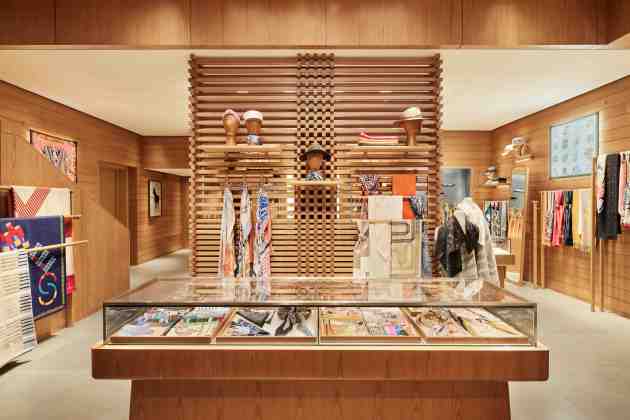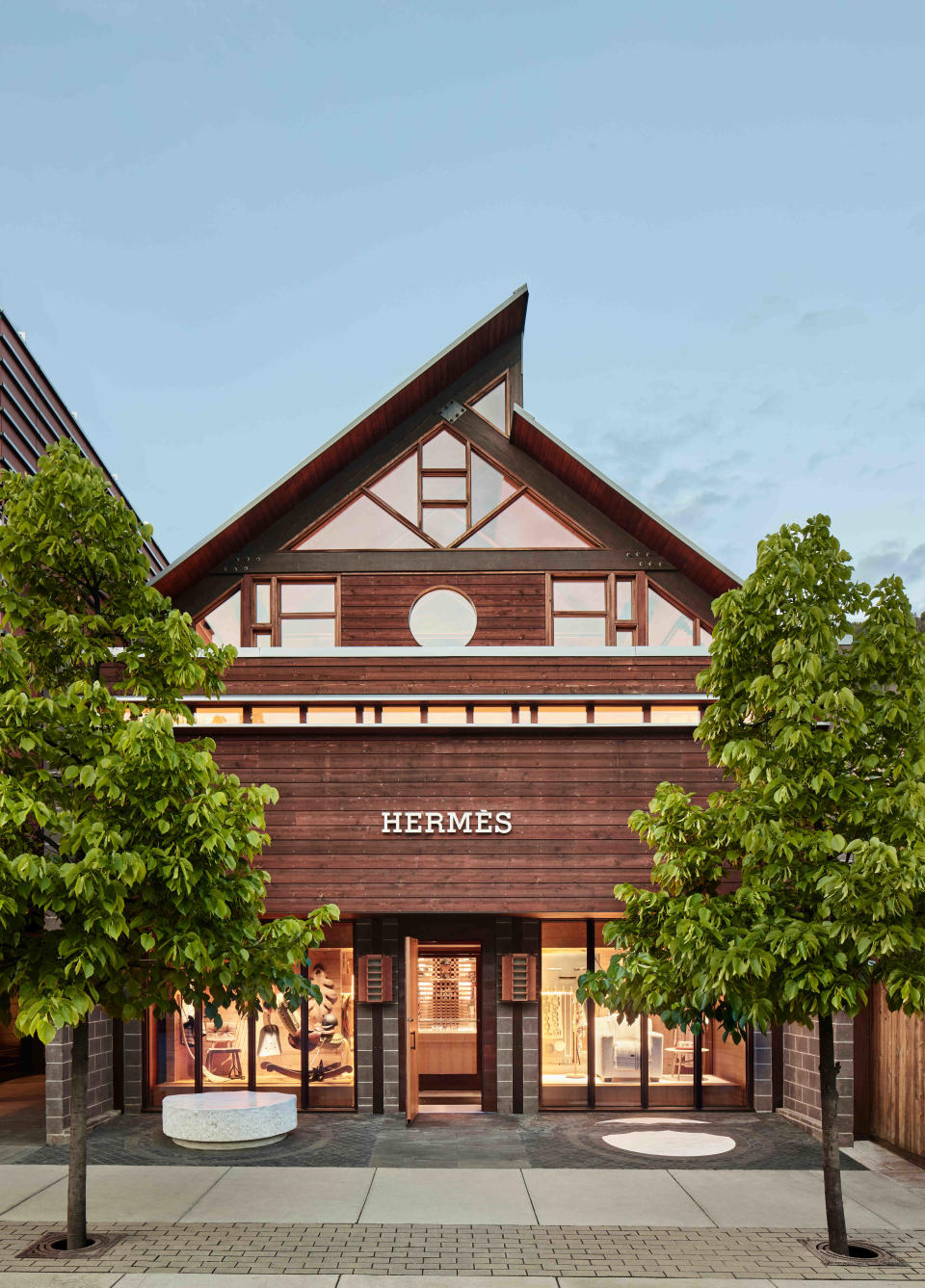Hermès U.S.’ New President Diane Mahady on the Brand’s Love Affair With Retail

Hermès has been on a tear lately, opening or refreshing retail stores in several cities around the U.S. The biggest statement came last fall when the French luxury brand took the wraps off a seven-story, 45,000-square-foot luxury emporium on New York’s Madison Avenue.
While the newest addition in Aspen, Colorado, which opens on Friday, may not be the same size or scope, it is nonetheless a reflection of the company’s ability to blend into a community while remaining true to a heritage that dates to 1837.
More from WWD
The new store, Hermès’ 34th in the U.S. and second in the state of Colorado, features carpets reminiscent of moss, gray-blue Aspen stone floors, honey-colored local larch wood on the staircase and a bay window that offers a panoramic view of the neighboring mountains. It was designed by the Parisian architectural firm RDAI and features 16 métiers, or departments.
The ground floor features men’s and women’s silk collections, fashion accessories, perfumes and beauty along with the brand’s signature leather goods. The mezzanine, which is designed to look like a cabinet of curiosities, offers the equestrian collections, and the second floor houses shoes, men’s and women’s ready-to-wear, jewelry and watches.
The shop is filled with original artworks including a piece from Jean-Luc Favéro dedicated to piebald horses from the Émile Hermès collection that stands next to a photograph by Yann Stofer titled Horse in the Snow. There’s also a winter scene drawn by George Barbier in the 1920s and a special window designed by Mexican artist Raul de Lara.
Overseeing the opening of this store and the rest of Hermès’ retail plans in the U.S. is Diane Mahady, who took over on April 1 as president of the American division, succeeding longtime chief Robert Chavez, who moved into a new role as executive chairman.

Mahady has a rich résumé that includes merchandising roles at Coach, Louis Vuitton, Zegna and Saks Fifth Avenue. She joined Hermès two years ago as executive vice president, working closely with Chavez, whom she said continues to consult on real estate and other issues. “He’s an amazing colleague and really built the brand here,” she said in the first interview since her promotion. “So it’s great to have him as a resource.”
She said that although Aspen may be viewed as a winter destination, it has evolved into a year-round resort community. “Post-COVID-19, we have found that people have more flexibility in the way they live and we think Aspen will be a terrific market for us.”
It’s also indicative of Hermès’ willingness to try unconventional locations. That was evident when it opened a store last year in Austin, Texas — not in a luxury mall but on Congress Street, known for its lively music and restaurant scene.
“Austin’s been terrific for us,” Malady said. “We have a very loyal client base and we’re really a destination. What we look for in a store location is something where you can really express the brand in the right way. No two stores are the same. Sometimes we look for more trafficked environments, sometimes we look for something hyperlocal. Austin was a new market for us. But we feel we’re more integrated in the community being in that location.”
Hermès is also working on a location in the Williamsburg section of Brooklyn, New York, another spot filled with trendy, youth-oriented boutiques. Until the space is ready, the brand is operating in a temporary location, she said, that is intended to express that Hermès is “a super humble, fun brand,” she said. “Sometimes people have a different perception of the brand, so [it’s important] for us to be able to show that we’re warm and welcoming, and not so serious.”
Since she became president, Mahady said she’s been asked numerous times how she is going to make her mark on the business, a question she finds almost puzzling.
“Everyone asks what I’m going to change,” she said. “But this is not a brand that needs to be changed. It’s a very healthy business with a terrific familial culture and very high retention rates here in the U.S. We’ve had explosive growth in the last two years, so now it’s really about how we prepare the brand for the future and ensure we can continue to deliver the level of service that is fundamental to the brand.”
What is also fundamental to the brand is its retail stores. With the exception of a few categories such as fragrance, watches and some home products, Hermès no longer wholesales and sells directly to consumers through its fleet of more than 300 stores in 45 countries as well as online.
In the U.S., the company opened a store in Naples, Florida, in February, and is now focused on Aspen, a market Mahady said is “a natural market for us.” Next up will be a second store in the Los Angeles market in Topanga, where she said Hermès is “a little under-penetrated.” It is slated to open in July.
“The West Coast is very important to us, between Hawaii, Los Angeles, Las Vegas,” she said. “So to be able to serve as more clients in Los Angeles area with a second store made a lot of sense.” She said to “create some energy” around the opening, Hermès will host a special experiential event, the Wings of Hermès, that will be a mixture of poetry and cinema. It will be held in Santa Monica from July 15 to 23, just before the store opens.
Then the focus will turn to Chicago, which is getting a facelift. “It’s a great market for us. We’ve been there since 1990 and we’re in a temporary store right now because we’re expanding the store on Oak Street. We’re adding a third level, which allows us to have a VIP room with enhanced services.” That is expected to open at the end of October, she said, at which point Hermès will being its interactive exhibit, Hermès in the Making, to the city. That installation focuses on the artisans who create the brand’s products.
The final project of the year will be the store at the Bellagio hotel in Las Vegas, one of three in that city, that is being renovated and is expected to be completed in November.
“Each of our stores is very site specific,” she said. “So even though there are three stores in Vegas, they all have a very different personality, a different aesthetic, a different assortment.”
Looking ahead to next year, Mahady said Hermès will continue to invest in renovating some of its existing stores and opening others. A new unit is slated for Princeton, New Jersey, and the existing store in Atlanta is moving from Buckhead to the upscale Phipps Plaza.
Beyond that, Mahady said the company plans to add a couple of new stores in the U.S. annually, in combination with renovations. “We’re very deliberate in our rollout. It would need to be the right location in the right market.”
Turning to the U.S. flagship on Madison Avenue, she said sales have been “outperforming expectations” since the September opening. “We’re blessed to have a really diverse client base and there are a lot of great sales associates with loyal followings.” In addition, the design of the store, with comfortable seating areas throughout the interior and an outdoor garden, creates a “more residential feeling,” she contended. “Our clients like to spend the day with us. It’s an enjoyable experience, not transactional, and is really relationship building. We’re really happy with what we’ve been able to achieve here.”
Mahady said Hermès remains enamored with what can be achieved in physical locations.
“We love retail,” she said. “This is a sixth-generation brand and we control every aspect of the business. The average time we’ve worked with any of our suppliers is 20 years. People often talk about the scarcity of the brand, but it’s really because we’re maniacal about quality. That’s been our business model and will continue to be our business model. And in our own retail environment, we can most control it.”
So while the U.S. retail count is only percent of the global total, Mahady said there’s no rush to dramatically increase the number here.
“Part of the beauty of the brand is we’re selective in the distribution,” she said. “We don’t want to spread ourselves too thin. It’s still challenging for us to keep up from a production standpoint, so we want to ensure that the existing stores get the best experience possible without taking on too much.”
Best of WWD

